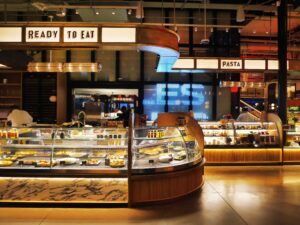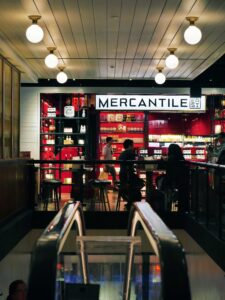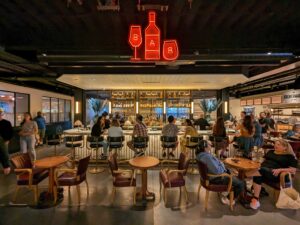Writing & Photography by Justin Negard
For over 180 years, the Fulton Fish Market in lower Manhattan was a true center of New York City commerce. Founded in 1822, this bustling market was one of the busiest fish markets in the world, and it holds a nearly two-hundred-year history that began before the Civil War and lasted through its mafia-laden legacy of the 20th century.
The Tin Building, built in 1907, served as the central hub for the Fulton Fish Market. For almost a century, the building was a gritty and foul-smelling landmark in the area, which became more famous for police raids and mafia crackdowns than salmon and tilapia. In 2005, the market left its headquarters and moved north to the Bronx where it remains today.
In the years following its closing, Chef Jean-Georges Vongerichten (yes, that Jean-Georges) took over the space, altering and renovating the historic landmark into a cleaner, more sophisticated marketplace. The project took eight years to complete, and it opened to the public in 2022.
This new “Tin Building by Jean-Georges” nods to the past while embracing the present; the brass-trimmed open market celebrates the history of the area while drawing in tourists and the newly gentrified Brooklynites across the nearby East River. Yet there is more retro charm here than any hipster vinyl shop could offer, and the dining options certainly provide a legitimate culinary experience.

Shopping (sort of)
The first floor of the Tin Building features a rich market of produce, meat and fish. Glass displays line the left and right of the ground floor, selling imported cheeses and wide-eyed salmon. Thick cuts of beef, stacks of artichokes, tomatoes and vegetables of all kinds can be purchased here, along with fresh breads and pastries.
The second floor is more specialized, with high-end culinary ingredients divided up by region and cooking style. The shop Mercantile offers products such as olive oils and flour, but fancier. The selection is legit for any chef’s cupboard, although these high-end varieties come at an equally high-end price.
Next to Mercantile, you’ll find Mercantile East, which, as you might guess, sells an assorted lineup of Southeast Asian food products. This charming storefront hides a secret beyond the velvet curtains in the back – what initially appears to be nothing more than a storage room is actually a hidden bar and restaurant.
Enter the House of the Red Pearl.
Decked out in retro Southeast Asian decor befitting an old-fashioned Hollywood film, this hidden dining room leaves you believing you somehow snuck in and maybe shouldn’t be there. With a diverse menu ranging from steamed black sea bass to octopus carpaccio, along with a variety of vegetarian noodle dishes, it’s a fun and tasty little secret.
But if you’re not hungry, make a stop at the speakeasy for a quick cocktail.
Or, throw away all thoughts of healthy eating and head straight to Spoiled Parrot. Seemingly torn from the pages of Roald Dahl, this confectionery shop is a colorful nook begging to be explored. The walls are perfectly organized with a wide range of cavity-inducing chocolates and gummies, and the pinstriped staff members roll cookie dough at the counter while greeting each and every visitor that strolls in. Your dentist will thank you.

Pull up a chair
As fun as it is to browse the display cases filled with veggies and meats, the Tin Building is really about eating. In addition to the “hidden” ones, there are a plethora of dining options, like the veggie-based Seeds & Weeds, the taco joint Taquito or the Shikku sushi bar. The world is truly your oyster (and yes, they have plenty of those, too).
The Frenchman’s Dough provides pizza selections that vary from lemon ricotta pies to white truffles. Despite its name, this is essentially an Italian eatery offering bucatini, trompetti and various other playful pasta shapes. Cold bottles of Tin Building-branded ginger soda are available to order, along with custom cocktails, like the basil lime daiquiri. While the size of your slice is a bit small for what you’re paying for, there’s still enough of a special twist here to justify a visit.
If it’s early in the day, give Double Yolk a try. It’s an egg-themed breakfast spot that cooks up cheese-infused sandwiches along with salmon, bacon, mushrooms and many other topping choices. There are also an array of morning juices to keep the energy flowing, and the nearby T. Cafe has you covered for all your caffeine and pastry requirements.
Later in the day (and, if the babysitting gods have blessed you for the evening), try a stop at the Fulton Fish Co. for a glass of wine and an oyster dinner. Or check out the bars, including Beer Here and The Cocktail Bar, both of which are appropriately named. A full cocktail tour isn’t a bad idea if an Uber or taxi can safely get you home. It’s an ideal treat before catching the sunset on the Brooklyn Bridge nearby.

The water’s edge
The party life extends beyond the Tin Building, as the revitalized South Street Seaport sits only a few feet away from its doors. A once-depressing tourist trap, it has been revamped with a plethora of additional restaurants and shopping choices for actual New Yorkers to visit (no Bubba Gump Shrimp here). Instead, restaurants like Momofuko Ssam Bar offer actual food and entertainment for actual New Yorkers. There’s even an outdoor ice rink for good measure.
Sure, there are still tour groups, selfie sticks and fanny packs (it’s not that easy to get rid of tourists), but the Seaport offers plenty for travelers and locals to enjoy.
Who knew it was possible?

Looking to the future
The Tin Building goes a long way in transforming what was a gritty New York neighborhood. Yes, it’s a bit overpriced and hipster-friendly, but New Yorkers with a longer memory will remember a far less romantic Fulton Fish Market. The Tin Building has changed all of that to create an exciting and very delicious new experience in Manhattan.
This article was published in the July/August 2023 print edition of Katonah Connect.
Tin Building by Jean-Georges
96 South St. New York, NY 10036
House of the Red Pearl
The Cocktail Bar
Beer Here
Double Yolk
Taquito
T. Cafe
Fulton Fish Co.
T. Brasserie
Shikku
The Frenchman’s Dough
Seeds & Weeds
Mercantile
Mercantile East
Momofuku Ssam Bar
89 South St. Pier 17, New York, NY 10038
Winterland
89 South St. Pier 17, New York, NY 10038

Justin is an award-winning designer and photographer. He was the owner and creative director at Future Boy Design, producing work for clients such as National Parks Service, Vintage Cinemas, The Tarrytown Music Hall, and others. His work has appeared in Bloomberg TV, South by Southwest (SXSW), Edible Magazine, Westchester Magazine, Refinery 29, the Art Directors Club, AIGA and more.
Justin is a two-time winner of the International Design Awards, American Photography and Latin America Fotografia. Vice News has called Justin Negard as “one of the best artists working today.”
He is the author of two books, On Design, which discusses principles and the business of design, and Bogotà which is a photographic journey through the Colombian capital.
Additionally, Justin has served as Creative Director at CityMouse Inc., an NYC-based design firm which provides accessible design for people with disabilities, and has been awarded by the City of New York, MIT Media Lab and South By Southwest.
He lives in Katonah with his wonderfully patient wife, son and daughter.










